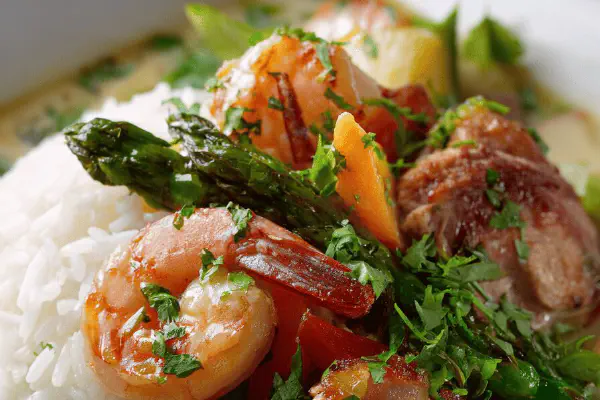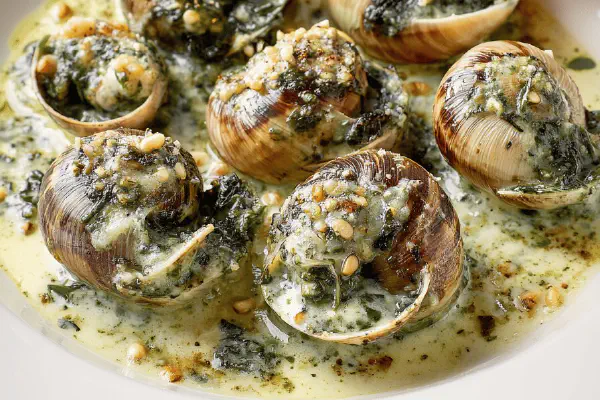Featured Recipe
Rustic Bouillabaisse Variation

By Kate
"
Fish broth simmered from mixed whole fish, tomatoes, aromatics. Finished with layered garnish of crispy onions, lightly fried potatoes, and firm fish fillets. Served with garlic-rubbed toasts topped by saffron aioli. Variations include substituting cod for salmon and fennel for leek. Thickened and strained for clarity. Cooking times adjusted for thicker fillets. Familiar, forgiving, and sturdy; a base to improvise around. Handling whole fish heads and bones builds depth. Timing focused on visual cues and texture. Garnish combines textural contrasts and bright punchy flavors. A hearty, rustic seafood soup that rewards patience and attention.
"
Prep:
25 min
Cook:
Total:
Serves:
4 servings
French
seafood
soup
hearty
garnish
Introduction
Fish bones simmering, broth thickens with tomato paste and herbs. Aromas rising—garlic, fennel, slow caramelized onions. Layers building—crisp toast, soft potatoes, tender fish fillets just cooked through. Timing critical. Not too soft, not too raw. Hands on, eyes sharp. Fish flesh firm, but yield under slight pressure. The smell—salty sea mingled with earthiness of fennel replaces typical leek. Toast rubbed heavily with garlic, saturated with saffron aioli punch. Ingredients familiar but changed, each step measured by sight, scent, touch. A bowl well worth the patience. No shortcuts if you want depth. De-boning makes the broth clean, pure essence. Texture—potatoes still hold but yielding—onions baked golden, sweetness released. Classic technique twisted, stays true underneath. The kitchen alive with simmer, sizzle, faint crackle.
Ingredients
Garnish
- 30 ml olive oil
- 1 medium onion, thinly sliced into rings
- 500 g potatoes, peeled, sliced 1 cm thick
- 600 g mixed fish fillets, skin removed and sliced into chunks (cod instead of salmon, sea bass, monkfish)
- 12 toasted bread slices
- 1 garlic clove halved
- 1 recipe saffron aioli (rouille variant)
- 60 g grated gruyère cheese (optional)
About the ingredients
Whole fish is gold here—weight your broth on bones, skin, heads. Gets you flavour no cube matches. When unavailable, use firm fleshed fillets thick enough to not turn mush, cod or seabass work. Tomato paste dimples flavor and aroma, boost umami—don’t skip. Fennel instead of leek? Adds pungent sparkle; if too strong, rinse slices briefly in cold water. Garlic dominates croûtons, essential for that punch. Oil: robust olive oil or grapeseed for neutral heat. Potatoes—waxy types hold shape under sauce better here; softer starches risk falling apart. Cheese optional but adds salty, melty finish. Rouille — saffron aioli here—peppery, garlic, a touch of heat; swap with mayo plus smoked paprika if pressed. Straining broth twice makes sure no gritty surprise slips through your spoon. Season sparingly before and after; salt traps flavors without taking over.
Method
Fish Broth
- Heat olive oil in large pot over medium heat. Add fish pieces, tomatoes, onion, fennel replacing leek, and garlic. Sauté until veggies soften, about 8 minutes. Stir in tomato paste coating ingredients evenly. Smoke from mingling tomato paste and fish fat develops flavor. Add water, salt, bouquet garni. Bring to boil, skim any foam quickly. Lower heat; simmer gently 12 minutes. Watch liquid reduce slightly, fish chunks opaque but not falling apart. Turn off heat; remove larger fish bones and any tougher chunks. Blend mixture with immersion blender until creamy but not too fine. Strain through fine sieve into another pot or bowl. Press solids firmly to extract maximum broth. Discard residues.
- Heat olive oil on medium-high in wide skillet. Spread onion rings evenly, then layer potato slices to cover pan base. Season with salt and pepper. Stir occasionally but keep mostly layered. Onion edges turn golden, potatoes starting to soften after 7 minutes. Lay fish chunks atop potatoes; season again lightly. Pour fish broth over just enough to cover fillets. Cover pan with tight lid. Simmer 7-9 minutes depending on thickness. Fish should be firm to touch, flakes separating but holding shape. Remove cooked fish pieces promptly to keep from overcooking. Keep warm.
- Rub toasted bread liberally with cut garlic clove — a must for authenticity. Spread saffron aioli generously on toasts. Optional gruyère can be melted on top briefly under broiler or served as is. Distribute onion-potato mixture onto deep plates. Nestle fish fillets carefully. Ladle warm fish broth over everything. Place toasted croûtons alongside. Serve immediately to preserve contrast between hot broth and crusty bread. The aioli introduces heat and richness balancing the broth’s sharpness.
- If whole fish not available, substitute with fish heads and bones sourced separately or add clam shells for additional marine depth. Cod replaces salmon well for milder flavor and firmer texture. Fennel is woody but aromatic, a nice twist substituting leek that softens more quickly but lacks sweetness depth. Adjust simmer times based on fish cut size; thicker means longer but avoid drying fillets out. For easier cleanup, strain broth twice if too gritty. Too little liquid? Add boiling water, too watery? Reduce uncovered after straining.
- Saffron aioli can be replaced with basic garlic mayo if saffron unavailable but loses characteristic warmth. Removing skin is key to prevent unwanted slime texture in broth. Use a ladle to gently break up pieces while blending. Skim foam often to prevent any bitterness. Crusty toasted bread is non-negotiable texture. If you prefer sharper broth, add a pinch of smoked paprika or cayenne before simmering.
Garnish Prep
Serve
Notes & Troubleshooting
Technique Tips
Oil heats until shimmers but no smoke. Vegetables softened gently—not burnt—avoids bitterness. Tomato paste must toast lightly before adding water for richness; otherwise, it tastes canned. Simmer fish gently; patience key: too hot fragments flesh, too cold leaves raw spots. Blending after removing bones ensures silky broth free of splinter risks; strain immediately—no exceptions—cleans clarity, texture. Layer garnishes carefully, so potatoes cook evenly under onion crown. Cover, avoid lifting lid repeatedly—steam cooks fish gently, holds moisture. Fish done when opaque but firm—test with finger gently. Serve quickly; extended waiting drains fish juices, dulls fresh edges. Toasts rubbed with garlic while hot; timing here means difference between fiery or faint flavor. Finally, ladle broth last-minute or it’ll sog your garnishes. Tweak broth thickness by reducing longer uncovered before adding to garnish pan. Precision comes from practice, not clocks.
Chef's Notes
- 💡 Use whole fish for broth. Fish heads, bones add depth. Firm fish preferred. Cod, snapper, seabass work. Freshness key here. Use skinless fillets.
- 💡 Tomato paste is essential for richness. Toast it briefly—brings out flavor. Don’t skip it. Helps the broth; use it right. Layer ingredients well.
- 💡 For garnishes, use waxy potatoes. They hold shape better. If using waxy types, avoid starchy ones. Fry onions slowly; golden is the target. Don't rush.
- 💡 Timing is critical. Simmer carefully; fish quickly turns mush. Less heat avoids overcooking, too high can make fish tough. Check doneness by touch.
- 💡 If broth seems gritty, strain twice. Keeps it clean. Want more flavor? Add herbs but taste as you go. Balance the seasonings; don't overdo.
Kitchen Wisdom
What to do if I can't find whole fish?
Use fish heads or just fillets. It'll alter flavor; still good if chosen well. Consider clam shells.
What if the broth is too thin?
Boil uncovered to reduce. Concentrate flavor. Too thick? Add boiling water slowly. Stir and taste often.
Common issue with fish overcooking?
Reduce heat immediately. Fish needs attention. Remove from heat when firm but flaky—check often.
How to store leftovers?
Broth separates well. Keep fish and broth aside. Refrigerate in airtight. Reheat gently; don’t boil again. Fresh is better.



